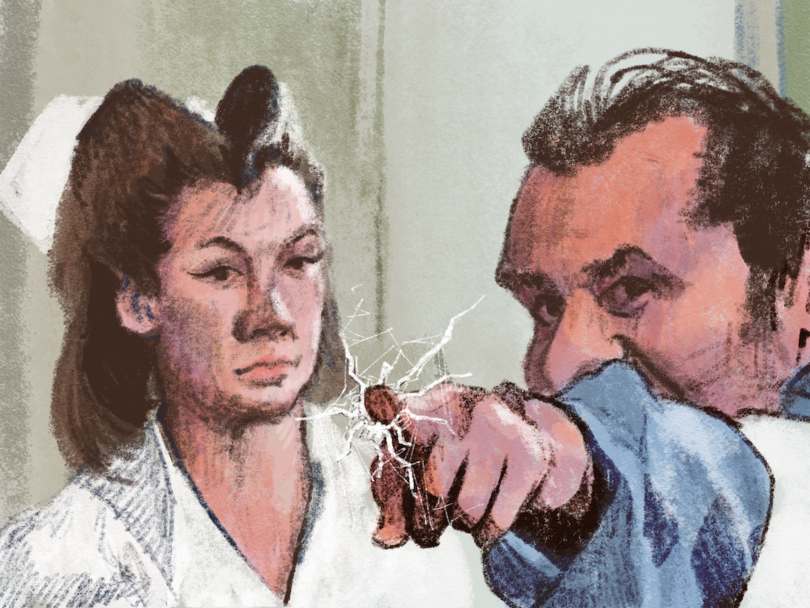‘One Flew Over the Cuckoo’s Nest’ poignantly critiques healthcare system

Nurse Ratched, the main antagonist of “One Flew Over the Cuckoo’s Nest,” is often counted as one of the most evil characters of all time. Our columnist says that though her actions are deplorable, viewers should take a more nuanced view of the character’s interactions with her psychiatric patients. Emma Lee | Contributing Illustrator
Editor’s note: this story includes mention of rape, sexual assault, violence and suicide.
Get the latest Syracuse news delivered right to your inbox.
Subscribe to our newsletter here.
Jack Nicholson accepted the BAFTA award for Best Actor in a Leading Role from the set of “One Flew Over the Cuckoo’s Nest” in 1975. In unforgettable fashion, the live broadcast featured Nicholson’s fellow cast members — who portrayed psychiatric patients — surrounding him while remaining in character. The unprecedented nature of delivering an acceptance speech from a psychiatric ward reflects the authenticity and significance of “Cuckoo’s Nest.”
As the next entry in Fathom Entertainment’s Big Screen Classics series, “Cuckoo’s Nest” returns to theaters, celebrating its 50th anniversary with screenings on July 13 and 16.
Set in the early 1960s, convict Randle Patrick McMurphy (Jack Nicholson) fakes a mental illness to avoid work at a prison farm. He believes serving his sentence at a psychiatric ward is an easier alternative. While McMurphy defies the cruel and manipulative Nurse Ratched (Louise Fletcher), he emerges as a symbol of hope and leadership to the other patients, encouraging them to embrace individuality and appreciate the pleasures of life.
Filming primarily in the psychiatric ward is a risky venture, but it pays off for “Cuckoo’s Nest.” The film’s greatness starts with its atmosphere, which Jack Nitzsche’s eerie yet uplifting score enhances. But when the score settles down, the environment stands out as its own character.
By shooting on location at the Oregon State Mental Hospital, director Miloš Forman unlocks a supreme level of authenticity. Dean R. Brooks, the superintendent of the hospital, was cast as the head doctor, and Forman — who spent time at the ward before filming — included real patients as extras.
“Cuckoo’s Nest” thrives on its acting masterclass. The cast features legends like Danny DeVito, Scatman Crothers and Christopher Lloyd, but Nicholson — who won his first Oscar for his performance as McMurphy— is truly at the top of his game. His distinguished eyebrows, signature smile and iconic receding hairline are on display, but Nicholson’s facial expressions, hand gestures and especially his line delivery solidify this as one of the greatest performances to grace the screen.
Fletcher’s top-notch performance as Ratched also brought home an Oscar. She played the cold-hearted, callous nurse so perfectly that she admitted she can’t watch the film due to the character’s cruelty.
“Cuckoo’s Nest” remains one of the most critically acclaimed films of all time due to its multifaceted, thought-provoking themes, like institutional control. It’s a rare picture, eliciting a variety of responses from viewers. Even some original audiences didn’t take key scenes seriously, possibly taking the film to be more comedic than it really is.
Forman’s treatment of characters’ backgrounds reveals the film’s invitation for open interpretation. One patient, Chief (Will Sampson), pretends to be deaf and mute. His motives, how he ended up in the ward and why he never attempted to escape (before McMurphy arrived) aren’t explicitly revealed. In my head, I’ve come up with an entire backstory for Chief, and I encourage you to do the same — make it your own movie.
“Cuckoo’s Nest” was a very formative film for me, but upon rewatching it, my perspective on the clash between McMurphy and Ratched — arguably the most interesting part of the narrative — is notably different. The conflict between the two characters is a canvas for addressing themes like systemic oppression, the dehumanization of psychiatric patients and the dangers of conformity.
After first watching “Cuckoo’s Nest,” I agreed with the many lists touting Ratched as one of the most evil villains in cinema. But the struggle between McMurphy and Ratched is more nuanced than just good vs. evil or protagonist vs. antagonist.
McMurphy serves as the champion, attempting to liberate the patients from Ratched’s shackles and inspiring them to suck the marrow out of life. He organizes a basketball game, plays blackjack and memorably commentates a fake World Series scenario when Ratched refuses to turn on the television. His morals evolve throughout the film, eventually displaying selflessness: a transformation from his initial choice to escape a harsh punishment.
While outside in the exercise yard, Chief boosts McMurphy over the fence so he can hijack a hospital bus and take the patients on a fishing trip. Instead of escaping unnoticed, McMurphy gives his colleagues a taste of freedom, even resembling a father figure as he helps reel in the fish. The scene may feel out of place, but the change of scenery reflects institutional rebellion and the development of McMurphy’s character.
Despite McMurphy’s positive impact, he’s not your cookie-cutter, purely ethical protagonist. McMurphy was charged with statutory rape, faked mental illness and attacked multiple hospital workers, including almost killing Ratched. While he’s easy to root for, McMurphy has skeletons in his closet, making him a classic anti-hero.
The extremely unlikeable and power-hungry Ratched appears cold and unsympathetic throughout the film’s entirety. She shows no signs of empathy during group therapy sessions, forces patients to take undisclosed medication and is the driving force for extending McMurphy’s containment at the ward, along with manipulating and dehumanizing her other patients.
One can argue that Ratched is just doing her job and avoiding chaos. Her cruelty can be seen more as a product of the flawed healthcare system than as a reflection of her individual character. While Ratched is certainly the antagonist, her villainy is blown out of proportion.
“Cuckoo’s Nest” is one of three movies to sweep the “Big Five” Academy Awards for a reason, but when examined through a modern lens, controversies appear. The film — and even more so the novel — can be interpreted as misogynistic and racist to a degree. Women are represented only as authoritarian figures and prostitutes, while the hospital attendees are mostly Black men. Oversimplified portrayals of mental illness are also present, which sometimes leads to harmful stereotypes. Nonetheless, these contentious elements do not take away from the heart of the film: addressing the societal stigma around psychiatric patients and exposing the oppressive faults of the healthcare system.
The oversimplifications result in a more identifiable cast that features relatable characteristics like Bancini’s (Josip Elic) exhaustion, Billy’s (Brad Dourif) self-consciousness and Cheswick’s (Sydney Lassick) anxiety. McMurphy embraces his colleagues, ultimately building their self-esteem.
“What do you think you are for Christ’s sake, crazy or something? Well, you’re not!” McMurphy says to the fellow patients.
“Cuckoo’s Nest” culminates in an incredible ending that’s simultaneously sad, happy, poignant and hopeful, reinforcing the film’s authenticity and multifaceted nature.
Instead of buying into the standard hero vs. villain story, I encourage audiences to be open-minded when viewing “Cuckoo’s Nest,” or any movie. This unlocks new insights, nuanced perspectives and makes a film even more interesting.






